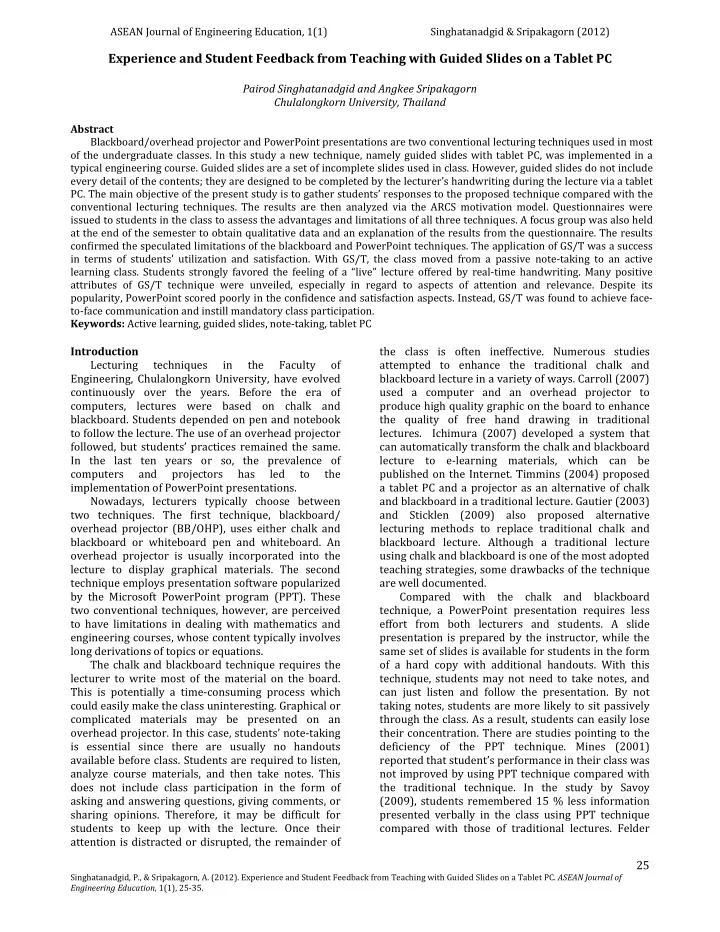

ASEAN Journal of Engineering Education, 1(1) Singhatanadgid & Sripakagorn (2012) Experience and Student Feedback from Teaching with Guided Slides on a Tablet PC Pairod Singhatanadgid and Angkee Sripakagorn Chulalongkorn University, Thailand Abstract Blackboard/overhead projector and PowerPoint presentations are two conventional lecturing techniques used in most of the undergraduate classes. In this study a new technique, namely guided slides with tablet PC, was implemented in a typical engineering course. Guided slides are a set of incomplete slides used in class. However, guided slides do not include every detail of the contents; they are designed to be completed by the lecturer’s handwriting during the lecture via a tablet PC. The main objective of the present study is to gather students’ responses to the proposed technique compared with the conventional lecturing techniques. The results are then analyzed via the ARCS motivation model. Questionnaires were issued to students in the class to assess the advantages and limitations of all three techniques. A focus group was also held at the end of the semester to obtain qualitative data and an explanation of the results from the questionnaire. The results confirmed the speculated limitations of the blackboard and PowerPoint techniques. The application of GS/T was a success in terms of students’ utilization and satisfaction. With GS/T, the class moved from a passive note‐taking to an active learning class. Students strongly favored the feeling of a “live” lecture offered by real‐time handwriting. Many positive attributes of GS/T technique were unveiled, especially in regard to aspects of attention and relevance. Despite its popularity, PowerPoint scored poorly in the confidence and satisfaction aspects. Instead, GS/T was found to achieve face‐ to‐face communication and instill mandatory class participation. Keywords: Active learning, guided slides, note‐taking, tablet PC Introduction the class is often ineffective. Numerous studies Lecturing techniques in the Faculty of attempted to enhance the traditional chalk and Engineering, Chulalongkorn University, have evolved blackboard lecture in a variety of ways. Carroll (2007) continuously over the years. Before the era of used a computer and an overhead projector to computers, lectures were based on chalk and produce high quality graphic on the board to enhance blackboard. Students depended on pen and notebook the quality of free hand drawing in traditional to follow the lecture. The use of an overhead projector lectures. Ichimura (2007) developed a system that followed, but students’ practices remained the same. can automatically transform the chalk and blackboard In the last ten years or so, the prevalence of lecture to e‐learning materials, which can be computers and projectors has led to the published on the Internet. Timmins (2004) proposed implementation of PowerPoint presentations. a tablet PC and a projector as an alternative of chalk Nowadays, lecturers typically choose between and blackboard in a traditional lecture. Gautier (2003) two techniques. The first technique, blackboard/ and Sticklen (2009) also proposed alternative overhead projector (BB/OHP), uses either chalk and lecturing methods to replace traditional chalk and blackboard or whiteboard pen and whiteboard. An blackboard lecture. Although a traditional lecture overhead projector is usually incorporated into the using chalk and blackboard is one of the most adopted lecture to display graphical materials. The second teaching strategies, some drawbacks of the technique technique employs presentation software popularized are well documented. by the Microsoft PowerPoint program (PPT). These Compared with the chalk and blackboard two conventional techniques, however, are perceived technique, a PowerPoint presentation requires less to have limitations in dealing with mathematics and effort from both lecturers and students. A slide engineering courses, whose content typically involves presentation is prepared by the instructor, while the long derivations of topics or equations. same set of slides is available for students in the form The chalk and blackboard technique requires the of a hard copy with additional handouts. With this lecturer to write most of the material on the board. technique, students may not need to take notes, and This is potentially a time‐consuming process which can just listen and follow the presentation. By not could easily make the class uninteresting. Graphical or taking notes, students are more likely to sit passively complicated materials may be presented on an through the class. As a result, students can easily lose overhead projector. In this case, students’ note‐taking their concentration. There are studies pointing to the is essential since there are usually no handouts deficiency of the PPT technique. Mines (2001) available before class. Students are required to listen, reported that student’s performance in their class was analyze course materials, and then take notes. This not improved by using PPT technique compared with does not include class participation in the form of the traditional technique. In the study by Savoy asking and answering questions, giving comments, or (2009), students remembered 15 % less information sharing opinions. Therefore, it may be difficult for presented verbally in the class using PPT technique students to keep up with the lecture. Once their compared with those of traditional lectures. Felder attention is distracted or disrupted, the remainder of 25 Singhatanadgid, P., & Sripakagorn, A. (2012). Experience and Student Feedback from Teaching with Guided Slides on a Tablet PC. ASEAN Journal of Engineering Education , 1(1), 25‐35.
Recommend
More recommend